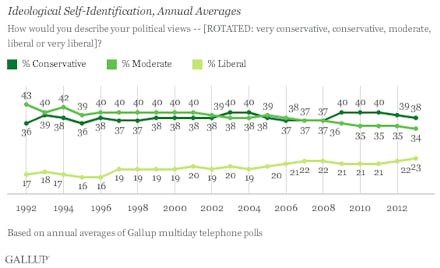Do More Americans Identify As Liberal Or Conservative? Check This Chart

The news: A poll released by Gallup on Friday indicated that Americans are more likely to identify as conservatives (38%) than as liberals (23%). But the conservative advantage is down to 15 percentage points as liberal identification reached its highest level since 1992.
Alongside the rise in liberal identification is a decline in moderate identification (34%), the lowest Gallup has measured, and down nine points since 1992. Moderates had been the largest ideological group throughout the 1990s, and competed with conservatives for the top spot during the 2000s. Since 2009, conservatives have consistently been the largest U.S. ideological group.
The figures are based on combined data from 13 separate Gallup polls, including interviews with more than 18,000 Americans, conducted in 2013.
The background: Although the shift may seem subtle at first glance, this increasing liberal identification means that liberals now hold the plurality of Democrats. Perhaps, this change corresponds with better times for the party, such as the marked dip in popularity of George W. Bush, the Afghanistan and Iraq wars and the two elections of President Obama. But it might also may more strongly reflect burgeoning public support for socially liberal policies like gay marriage and a new public focus on income inequality starting with the Occupy Wall Street movement. (Just look at how much has changed since Hillary Rodham Clinton refused to call herself a “liberal” during the 2008 election.)
At the same time, Republicans have become increasingly conservative with a series of primary election challenges for long-serving GOP members of Congress by candidates aligned with the Tea Party movement.
We're more polarized than ever: The continued Republican identification of conservative, the growing Democratic identification of liberal and the decline of those on both sides of the spectrum identifying as moderate lends itself to the argument that U.S. politics is, if possible, becoming even more polarized. This data confirms that Americans who identify with the two major parties are more ideologically homogeneous than in the past, a tendency that appears to be matched by the increasing polarization between Democratic and Republican members of Congress.
And how does the growing ideological rift between the two parties actually impact politics? The startling lack of action from congress last year and the government shutdown caused by House Republicans gave Congress their lowest approval rating ever last November and a majority of Americans also now believe the current Congress is the worst they’ve seen in their lifetime. It’s not too ridiculous to link this wide-scale incompetence to the ever-widening rift between ideologies in the nation as a whole.